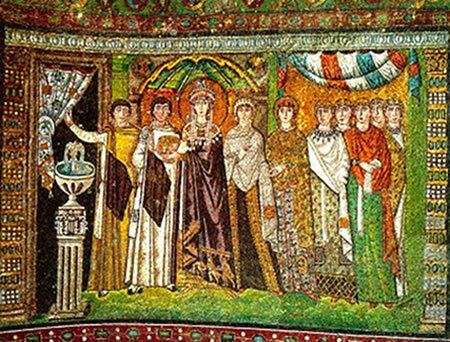The Byzantine Empire reached its political and cultural splendor during the rule of Emperor Justinian, who reigned from 527 to 565. The artistic productions of the period had a religious and educational character. They served to guide Christians through the reproduction of scenes from the life of Christ and also of the emperors, as they they symbolized the divine, the sacred and held the power of time and spirit, remembering that the political regime of the time was the theocracy. Thus, the religious preponderance in Byzantine Art was undeniable, but it also expressed the wealth and power with all the majestic character of a period, and represented the absolute authority, the superhuman and mystical greatness of the Emperor Justinian, who symbolized the figure of God in Earth.
To achieve these manifestations of power and religion through art, one of the techniques used by artists from the Byzantine period was frontality, that is, the figures were drawn from the front; with this technique the posture of the model or object was exposed to an exaggerated formalism, thus observing the absence of movement sensations and making the appreciator of the work a passive spectator, who saw in artistic production no other possibility of interpreting the work than the figure of sovereignty and sacred.
Byzantine art was appreciated both in the architecture and in the mosaics and decorations inside the churches. Byzantine mosaic represented luxury and sumptuousness. The technique consisted of drawing the figures by juxtaposing thousands of small colored stones, perhaps this art format is the most important expression of religious art. Although it was widely used in the Ancient World, it was in the Middle Ages, and especially in Byzantium, that this art was most produced and disseminated.
Do not stop now... There's more after the advertising ;)

Emperor Theodora- Byzantine Mosaic
Byzantine church mosaics were recognized for their splendor through sheer simplicity existing in the clarity of the contours and designs, in the creativity, in the coloring, in the half tone and in the luminosity. With the crisis after Justinian's government, religious art declined and profane art reappeared, which resumed ancient themes, but it was also renewed with influences from the East when Constantinople was taken by the Turks.
By Lilian Aguiar
Graduated in History
Brazil School Team
Would you like to reference this text in a school or academic work? Look:
AGUIAR, Lilian Maria Martins de. "The Religious Preponderance in Byzantine Art"; Brazil School. Available in: https://brasilescola.uol.com.br/historiag/a-preponderancia-religiosa-na-arte-bizantina.htm. Accessed on July 27, 2021.
